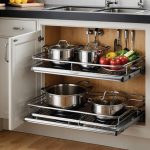Transforming Your Kitchen Space for Mindful Eating
A mindful kitchen design prioritizes creating a calming environment where relaxation and focus during meals are encouraged. This setting enhances the dining experience by ensuring that each element of the space contributes to a serene atmosphere. The importance of a cozy dining atmosphere cannot be overstated, as it allows diners to connect more deeply with their meals and company.
Key Elements of A Calming Kitchen
To achieve mindfulness in your kitchen, consider these design elements:
This might interest you : Preserve freshness and cut waste: the definitive handbook for efficient bread storage in small kitchens
- Lighting: Utilize soft, warm lights to create a soothing ambiance. Avoid harsh overhead lighting that could detract from the serenity of the space.
- Colors: Incorporate calming hues like soft blues, greens, or neutrals, using color psychology to positively influence mood.
- Sound and Scent: Consider ambient music or the gentle hum of a water feature, alongside subtle natural scents like lavender or chamomile.
Decluttering Tips
Begin by eliminating unnecessary items and maintaining organized storage to create an uncluttered space that promotes tranquility. Arrange your kitchen so that frequently used items are easily accessible, minimizing distractions and allowing uninterrupted focus on the dining experience.
Enhancing the dining experience through mindful kitchen design is about creating a harmonious space where every meal becomes an opportunity for mindfulness and connection.
Additional reading : Transform Your Kitchen’s Atmosphere: Explore the Health Benefits of UV-C Air Purifiers for Removing Dangerous Pollutants
Creative Seating Ideas for Enhanced Dining Experiences
Enhancing your dining experience can be as simple as introducing creative kitchen seating ideas that not only add comfort but also inject personality into the space. Unique dining arrangements ensure that family and guests feel at ease and create a memorable atmosphere.
Versatile Seating Solutions
Incorporating versatile seating such as benches, cushions, or stools can offer flexible arrangements that adapt to various needs. These options are especially beneficial for larger gatherings, allowing for spontaneous seating adjustments. For those with smaller kitchens, space-saving furniture like foldable chairs or extendable tables can maximize space without compromising on style or comfort.
Integrating Nature into Your Dining Area
Introducing natural elements can significantly enhance the dining atmosphere. Consider using plants as decorative items, which not only improve air quality but also add a touch of serenity. Outdoor seating or incorporating natural materials such as wood or stone can seamlessly blend the outdoors indoors, promoting a tranquil environment and fostering a connection during meals.
Personalizing Your Seating Arrangements
Tailor your seating arrangements to reflect personal style and embody warmth. Adding plush cushions or throw blankets can enhance coziness and make your space more inviting. Playing with art and colour can further emphasize ambiance, allowing your dining area to radiate a welcoming feel that speaks to its uniqueness.
Designing a Calming Atmosphere for Mindful Eating
Creating a calming dining atmosphere can significantly elevate your meal experiences by promoting relaxation and focus. Lighting plays a crucial role in this environment; using warm, soft lights can create a soothing ambiance, as opposed to the harshness of bright, overhead fixtures. Lighting should be strategically placed to highlight key areas, enhancing the overall harmony of the space.
Incorporating sound and scent contributes to a sensory dining experience. Gentle background music or natural sounds, like water moving softly, can enhance serenity. Introducing subtle aromas, such as lavender or chamomile, can boost tranquility and complement the dining setting.
Colour psychology is another powerful tool. Using calming colours, like soft blues and greens, can positively influence mood and create a comforting environment. These hues can be integrated through wall paint, table settings, and furnishings, leading to a coherent design that encourages mindfulness.
Mindful design tips emphasize minimalism; removing excess clutter is essential to maintaining focus and calmness. Creating dedicated spaces within your kitchen that are free from distractions allows you to savour each moment, transforming your dining experiences into opportunities for mindfulness and reflection.
Mindful Eating Practices to Complement Your Setting
Creating a conducive environment is just one part of enhancing the dining experience; mindful eating practices are the next step. Mindful eating habits focus on engaging the senses and being present with your food, promoting a more fulfilling meal time.
Preparing Meals with Mindfulness
Slow cooking techniques and intentional meal preparation enable greater mindfulness. They allow for attention to detail, elevating meal quality and fostering an organized dining experience. Meal prep helps manage ingredients thoughtfully, ensuring balanced nutrition. Choosing colourful, fresh ingredients enriches your food selection, setting the stage for aesthetic food presentation tips.
Engaging the Senses during Meals
A sensory dining experience amplifies connection with your meal. Implement rituals, like expressing gratitude before eating, to centre focus. Recognize and appreciate different flavours and textures, enhancing awareness and appreciation of the dish. This practice encourages diners to savour each bite, extending mealtime satisfaction.
Involving Family and Friends in Mindful Dining
Shared cooking or family meal prep enhances bonding. Rituals that embrace mindfulness, such as discussing the meal’s origin or ingredient benefits, foster deeper connections. Encourage active participation through communal tasks, creating an enriched and engaging dining environment. This shared experience strengthens ties and enriches the communal aspect of dining, nurturing both relationships and mindfulness.











